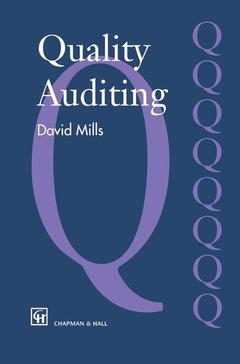Description
Quality Auditing, 1993
Author: Mills J.
Language: English
Keywords
Publication date: 09-2012
318 p. · 15.5x23.5 cm · Paperback
318 p. · 15.5x23.5 cm · Paperback
Description
/li>Contents
/li>
There are as many views on audits and auditing auditing as there are people who have ever thought about the subject and the process. Any author writing about it is faced with some common problems, such as how to make a description of a technical process anything less than dry to read. How to deal with the general belief that anyone can conduct an audit without any specific training or experience. Auditing is often viewed as a waste of time, money and resources with little, if any, real value to an organization. It is seen as something of a judgemental process. People see themselves as being under scrutiny and examination and as very few of us enjoy such a process, audits are not generally welcomed at first. I cannot claim to have found solutions to these problems or to have come up with an easy five-minute way of understand ing the detailed points that make up this whole subject. As with any form of technical textbook, this work must not be viewed as a volume to be read in one sitting from cover to cover but used to dip into as and when required. Thankfully the practice of auditing, in real life has compensa tions for those involved. Those being audited, the auditees, if sensible, will be able to learn from what is hoped will be an objective and skilled overview of the areas and subjects being audited.
One: An overview of audits.- Where have quality audits come from?.- Auditing status.- Where are quality audits heading?.- Two: What is a quality audit?.- Audit types.- Customer needs.- Audit categories.- Terms and difinitions.- Definitions published in standards.- Applications of definitions.- Three: Why audit?.- Audit objectives.- Compliance.- Effectiveness.- Mandatory audits.- Motivation for audits.- Continuity.- The auditee’s motivation for audit.- Relationships between the audit personnel.- Four: The audit maze.- Categories of audit.- Internal Audits.- External audits.- Extrinsic audits?.- Supplier visitations.- A need for sub-categories?.- Further audit definitions.- Audit types.- Performance audits.- Product audits.- Five: Audit boundaries.- Step 1. Reason.- Step 2. Measures.- Step 3. Coverage.- Step 4. Location.- Step 5. Resources.- Audit depth or involvement.- Resources.- Time.- Manpower.- Facilities.- Skills.- Audit scope decision.- Six: Audit personnel.- Personnel with accountability.- Audit team.- Size of team.- The make-up of a team.- Experts.- Observers.- Team selection.- Audit member’s tasks and responsibilities.- Lead auditor’s general responsibilities.- Lead auditor’s specific duties.- Objectivity of audit personnel.- Seven: Auditor qualifications.- Areas of competence.- Knowledge.- Human factors.- Eight: Audit activities.- The preparation phase.- The data collection phase.- Initial review phase.- The reporting phase.- Nine: The audit plan.- The audit plan.- Who is involved?.- Content of the plan.- Pre-announced or suprise audits?.- Ten: Working methods.- Audit assignments.- Solo auditing.- Auditing in pairs.- Team auditing.- Other team members.- Tasking the auditors.- Auditing tools.- To examine by asking questions.- The tactics of questioning.-Understanding the question.- The form of questions.- The summary question.- I may be stupid but?.- Intervals.- Input vs. output questioning.- Applied questioning.- Verification.- Eleven: Guiding the audit.- Audit checklists.- Aide-mémoire.- Guiding the process.- Lower order working documents.- Other working documents.- Twleve: On-site procedure.- Initial or opening meeting.- Examination.- The exit or closing meeting.- The ‘buffer’ stop situation.- Ethical questions.- Thirteen: Reporting the audit.- ‘In-process’ reports.- Audit results reporting.- Preparation of the report.- Acceptability of the report.- Strength and weakness reporting.- Corrective action.- Presentation of the report.- Fourteen: Problems during the audit.- Pre-audit problems.- ‘On-site’ auditing problems.- Timewasting.- Obstructing the audit.- The auditor’s difficulties.- Fifteen: Finished?.- Corrective action.- A poser for the auditor.- The final solution?.- Sixteen: Special cases?.- What special cases?.- The single product concept.- The case of the tangible vs. intangible.- Generic quality audits.- The case by definition.- The four categories.- Practical applications.- Conclusion.- Seventeen: Managing an audit programme.- The definition of audit programme management.- The functions of audit programme management.- Audit programme management staff.- Policy and strategy.- Provision of audit staff.- Audit team selection.- Audit performance monitoring.- Monitoring auditors’ performance and consistency.- Supplying the required training for auditors.- Audit effectiveness and worth.- Resourcing levels.- Operational review.- Codes of ethics.- Eighteen: Product auditing.- Definition and history.- Developments in product auditing.- Current product auditing processes.- The final goals.- Thecustomer expectation audit (CEA).- Use of the CEA type audit.- The management of a CEA programme.- Nineteen: Economical auditing.- Audit costs.- Sub-contracting the audit.- Systems audit benefits.- Control of systems audit costs.- Product audit benefits.- Control of product audit costs.- Twenty: Auditing at the end of the road.- Past and current status of auditing functions.- A future for the audit role?.- Future auditing methods.- Conclusion.- Twenty-one: Auditing in the ISO 9000 environment.- The first phase revisions.- The ten year review.- Reviews and audits — what’s the difference?.- Compliance with the 9000 series standards.- Understanding the standard’s requirements.- Relationship between quality systems compliance and product quality.- Does poor performance equal lack of conformity?.- Auditing to the ISO 9000 family of standards from the client’s view.- The auditor’s viewpoint and responsibilities.- Audit management.- The role of the consultant.- Integration.- References/Bibliography.
© 2024 LAVOISIER S.A.S.




